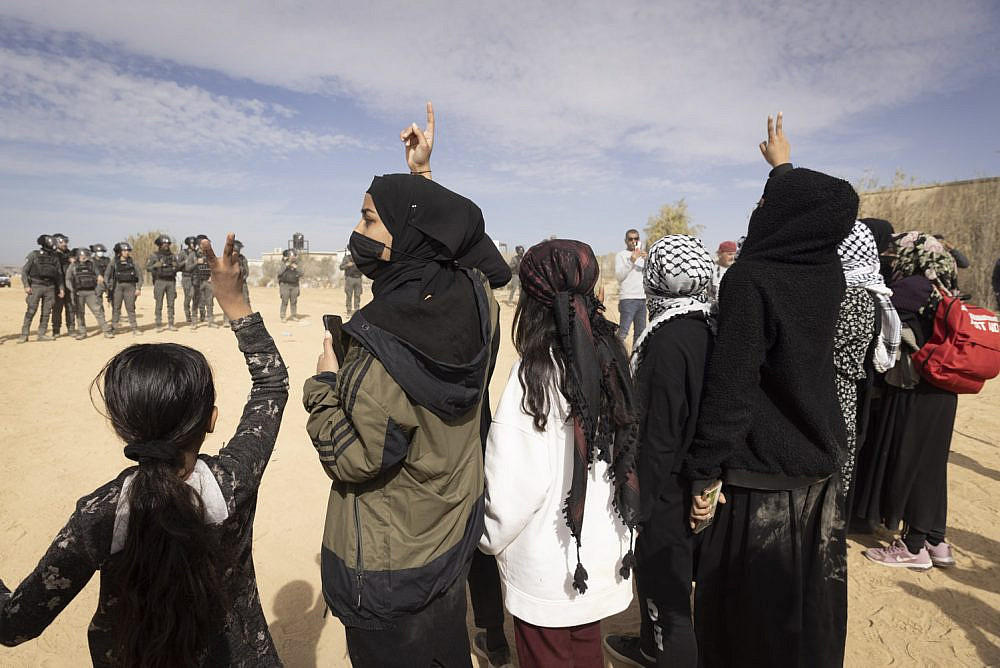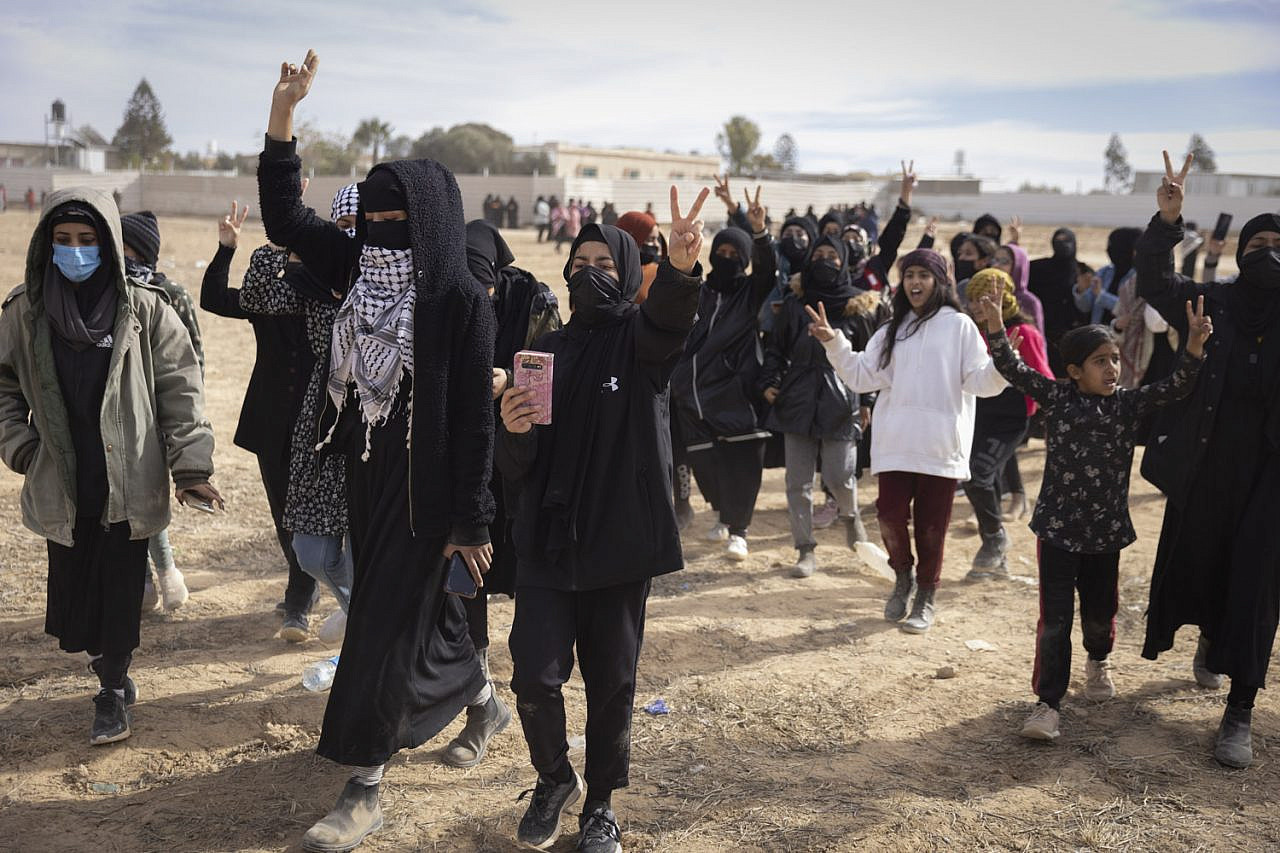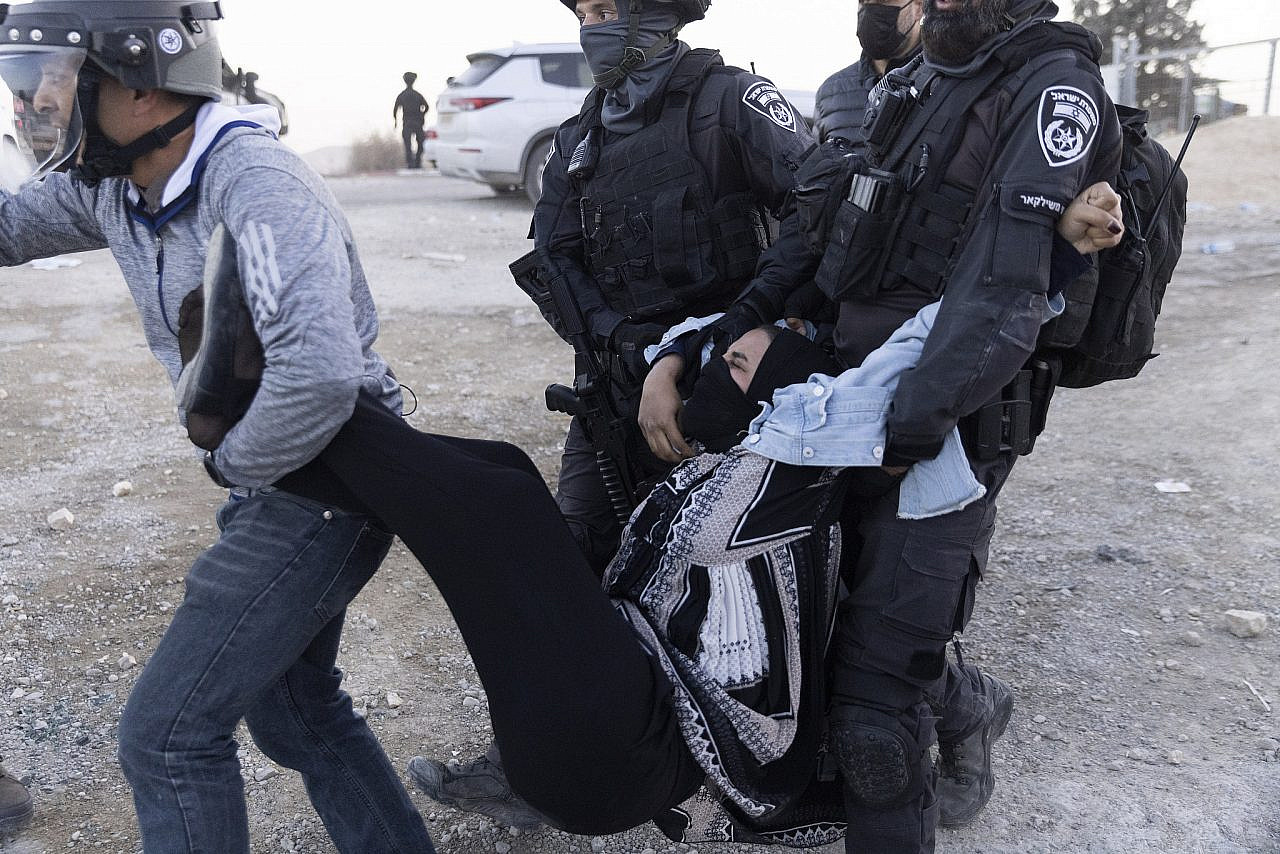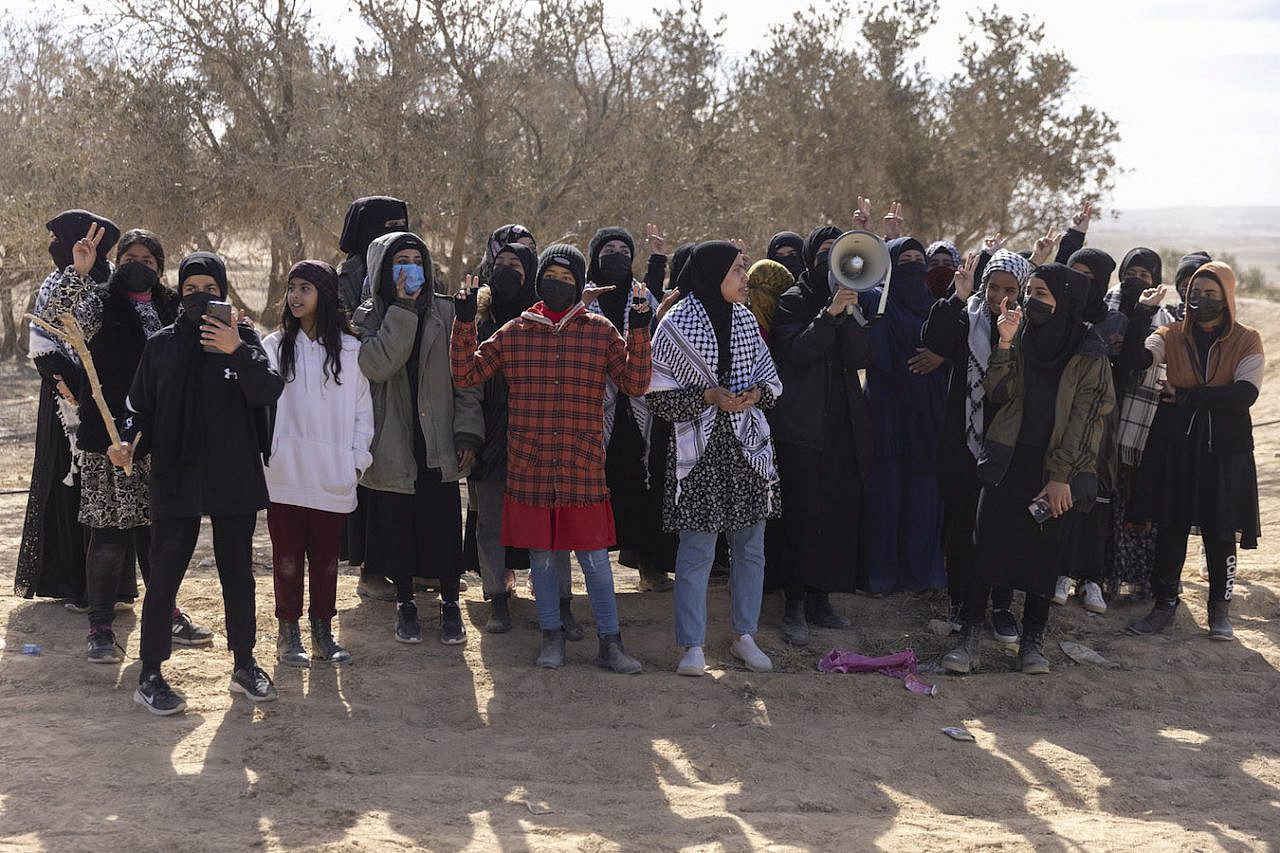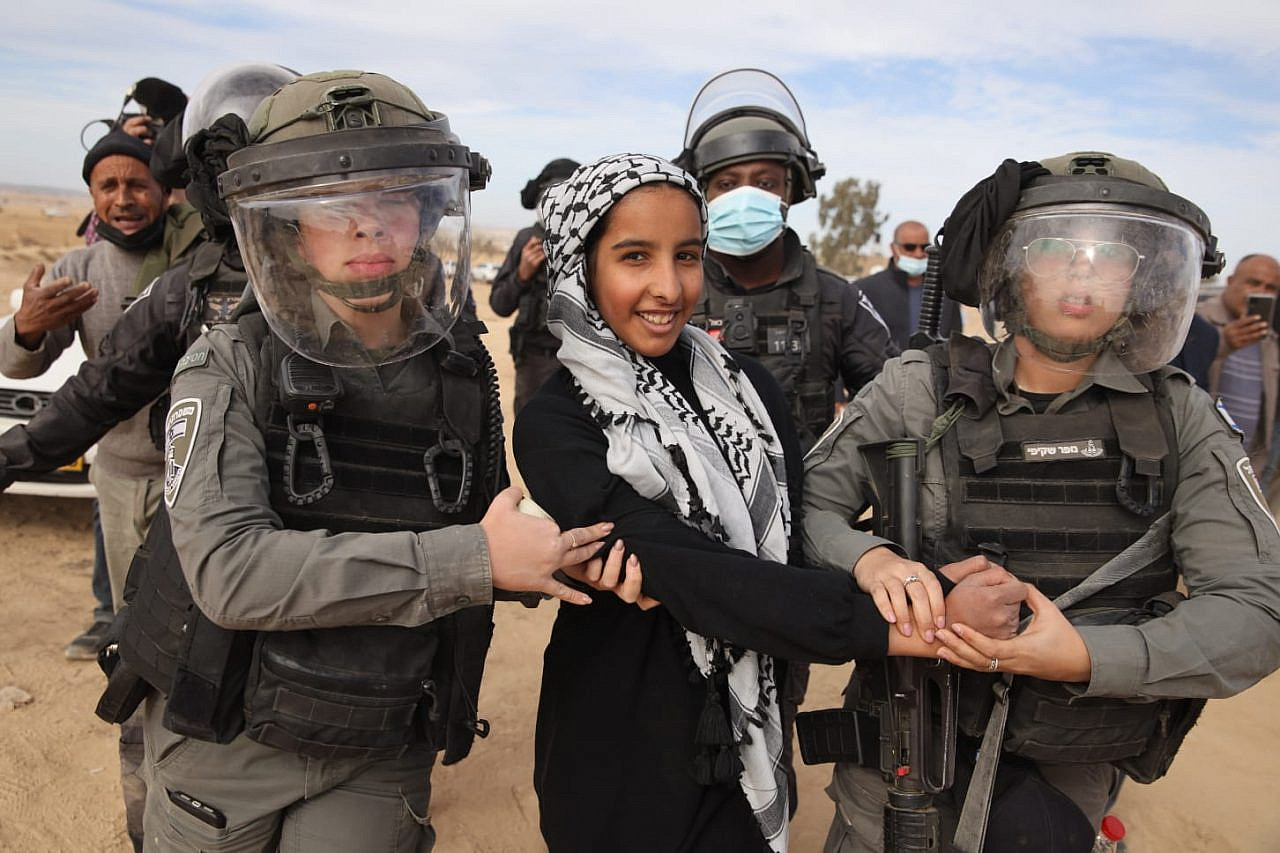A Brief Colonial History Of Ceylon(SriLanka)
Sri Lanka: One Island Two Nations
A Brief Colonial History Of Ceylon(SriLanka)
Sri Lanka: One Island Two Nations
(Full Story)
Search This Blog
Back to 500BC.
==========================
Thiranjala Weerasinghe sj.- One Island Two Nations
?????????????????????????????????????????????????Sunday, January 23, 2022
As Naqab protests intensify, Bedouin women are taking the helm
Women and girls are increasingly on the front lines of Bedouin resistance to Israel’s expropriation of their land — and they’re just getting started.
Bedouin women and girls protest Israel's afforestation and expropriation of their land, Sa’wa al-Atrash, Naqab, January 12, 2022. (Oren Ziv/Activestills.org)
Bedouin citizens in the Naqab/Negev are escalating their struggle against Israel’s Judaization policies, the expropriation of their land, and against the afforestation project of the Jewish National Fund at the expense of unrecognized villages. But those who have really come to the fore in this wave of protests are the women and girls from the villages facing dispossession, who went out and stood together with the men to confront the JNF’s bulldozers.
Anyone who has been following the generations-long struggle for the recognition and regularization of the Palestinians in the Naqab could not have failed to notice this phenomenon: in every protest there have been more and more women and girls standing on the front lines.
Twenty-six women, along with dozens of male activists and protesters, were arrested during demonstrations last week in the village of a-Sa’wa al-Atrash against the JNF’s plans to build a forest over Bedouin agricultural land. Most of the women were released to house arrest, with the exception of one young woman, 25-year-old Nawal Abu Kaf, whose detention was extended until this past Sunday. Abu Kaf, a student counselor at Sapir College who supports a family that lost its father, was arrested and beaten in full view of cameras. According to eyewitnesses, she was standing beside other activists, Jews and Arabs, and did not use violence.
Women also starred on social media in Arabic, Hebrew, and English. They placed themselves at the forefront of the media stage alongside veterans of the struggle — politicians and members of the unrecognized villages committee — as part of an unelected popular body comprising representatives from the unrecognized Bedouin villages, and which includes not a single woman.
‘People do not understand the reality of the Palestinians in Israel’
Eden al-Hajoj is an 18-year-old volunteer in the Ajik Association and teaches English to children in the village of Umm Batin. She found herself at the heart of the demonstrations last week, speaking to the camera in fluent and sharp English about what was happening around her. The video went viral on social media, after which she was interviewed by various media outlets.
Bedouin women and girls protest Israel’s afforestation and expropriation of their land, Sa’wa al-Atrash, Naqab, January 12, 2022. (Oren Ziv/Activestills.org)
Al-Hajoj attributes her English skills to the fact that she lived in Canada while her mother completed her doctoral studies there. According to her, despite the distance, she never stopped following the experiences of her village and the Naqab, where she was born and raised, and to which she would return.
“The discourse in Canada around Israel is biased,” says al-Hajoj. “People do not understand the reality of the Palestinians in Israel, and certainly not the reality of Bedouin society. So we had to be vigilant and we became ambassadors.
“The world must hear and see what is happening here with this military state, the so-called only democracy in the Middle East, that tramples over the rights of anyone who is not a Jew,” she continues. “I have a lot of followers, and they have the right to understand what me and my family are going through, to understand what Israel is really doing on the ground.
“Like the struggle in Sheikh Jarrah, without social media and without the livestreams of the El-Kurd twins, everything would have gone ahead smoothly and the world would have bought the Israeli narrative as if we, the Palestinians, were criminals and invaders to a territory that is not ours,” Al-Hajoj adds. “The opposite is true: I was born here, my father and grandfather have been here since before the establishment of the state. The JNF bulldozers are the invaders and the violent ones.”
Al-Hajoj wants to train other girls to have the courage to speak, because they have the tools — phones and internet — as well as what she calls “the simple truth”: the knowledge that “a society that was here before the establishment of the state will remain here and continue to oppose dispossession and oppression.”
The involvement of girls and women in the protest against the JNF afforestation project is a continuation of a revolution that women from the Naqab are leading, both politically and socially. For years, men and conservative movements, including the Islamic Movement, have opposed the presence of women on the front lines of mass events, for reasons of “modesty” and conservatism. Most of the time they wanted the women behind a separation sheet in protest tents. Feminists with a liberal agenda who were opposed to polygamy and underage marriage were not welcomed.
At the same time, it was women from the Naqab who carried on their shoulders the difficult task of empowering other women. They began working in NGOs that promote employment, learning, financial independence, advancing young women to academia, and especially education and welfare.
But with each achievement, the appetite for more grows. Every feminist realizes very quickly that it is impossible to separate the accessibility of higher education from an unrecognized village’s access to public transportation. That it is impossible to fight against dropping out of the education system without fighting for the right to open a school in the village. That women will not be able to work in Be’er Sheva, even as cleaners, if their tribe does not have a daycare center or nursery. All of these “women’s” issues are closely related to the status of the Bedouin in the Naqab, and to their struggle for land and against expulsion.
‘Women are everywhere and always have been’
Hanan Alsanah, an attorney, feminist social activist and executive director of the Negev Coexistence Forum for Civil Equality, has been active in women’s organizations for over two decades. I remind her that for many years we have met in every demonstration against femicide or and against house demolitions, but that many of these demonstrations were attended by only a few women, usually well-known activists and coordinators of various NGOs. Seeing what is happening in these new protests, I asked her whether she believes that something is changing.
Police arrest a woman during a Bedouin protest against Israel’s land expropriation and afforestation, outside Sa’wa al-Atrash, Naqab, January 13, 2022. (Oren Ziv/Activestills.org)
“It’s definitely a trend. Slow, but persistent,” says Alsanah. “Now, because everything is covered in the press, we’re paying attention [to the trend]. In 2011, we organized one of the first women’s protests outside the Naqab against the demolition of houses. There was an argument with the men: how do we take women to Jerusalem to demonstrate at the Knesset? We suggested a female-only demonstration. They couldn’t oppose women-only activities.
“We organized six full buses,” Alsanah recalls. “On each bus a local committee representative or a senior tribe member boarded as escorts. We did not find a single brave woman to take the stage. Only men spoke, it was jarring. Then Umm Fares from the village of Al-Zarnog went up, covered from head to toe and spoke very loudly.
“Women are everywhere and always have been, definitely as an active part of the crowd, but sometimes also on stage: in al-Araqib, in the big demonstration in Wadi al-Na’am, at the demolitions in Qasr al-Sir, in Umm Zarnok, in the opposition to the Prawer Plan, at the demolitions in Bir Hadaj,” Alsanah continues. “Women were at the front, on the ground, less on the stage. Today, it’s impossible to push them back. The men also understood the power of a woman with seven children standing in front of soldiers and a bulldozer.
“Today, I don’t have to organize buses. Women are organizing private vehicles for themselves.”
‘Raising children in the shadow of this tragedy is activism’
Huda Abu Obeid distinguished herself in her activities as a leader in the protest against the Prawer Plan in 2013, and today manages the lobbying and media department in the Negev Coexistence Forum. She shows me a photo from 1987 of women and their children in a demonstration against the expropriation of land belonging to the village of Lakiya.
“I was born in 1988, and I recognize women from the photo who are still at the heart of the struggle,” says Abu Obeid. “There’s no doubt that what’s happening here with the young women is a leap forward, but it is not new. Every Bedouin in the Naqab knows that they’re in the firing line and will someday need to resist — the incitement against us is unrelenting.
“Look, for example, at the powerful woman Fida’a Abu Kardod, a single mother whose house was demolished in 1994. She traveled to Jerusalem and set up a protest tent, staying in front of the Prime Minister’s Office for three months until her village, Abdah, was started on the process of recognition. They called her the Iron Lady. And she didn’t have Instagram.”
According to Abu Obeid, women’s organizations and shared society organizations took an active part in raising awareness — more so than political movements. Political parties, as well as the Arab Higher Monitoring Committee, which coordinates political activities among Palestinian citizens of Israel, are always slow to celebrate the achievements of popular protest on the ground, she says.
Bedouin women and girls protest Israel’s afforestation and expropriation of their land, Sa’wa al-Atrash, Naqab, January 12, 2022. (Oren Ziv/Activestills.org)
Abu Obeid believes that the revolution that young women in the Naqab are leading in terms of education, employment, and livelihood is giving them the strength and tools to speak out and protest. And although she is aware there are attempts to bring these young women down, like the claim that they only have time to protest because they are single, or that they may be the daughters of northern women and not really Bedouin to the bone, she rejects them. “We have become accustomed to these claims, which aim to divide women and reduce our power,” she says.
Social media, and especially Instagram and Tiktok, “are tools that were not available to girls previously,” Abu Obeid continues. “The protests in Sheikh Jarrah, which many of the girls follow, gave the impression that we are in the same story in the face of the establishment, and that we too can make our voices heard.”
Sabrin al-Asem, a journalist at the local “Voice of the Negev” radio station which she founded, thinks that the role of women in the protests intensified after a wave of house demolitions in Umm al-Hiran a few years ago. Women saw the demolitions, and decided to act.
“Raising children in the shadow of this tragedy is activism in my eyes,” says al-Asem. “Amid this distress, there’s no escape but to become an activist with a high political awareness. When your home is your kingdom, and they come to destroy it, women can’t remain silent anymore. Documenting and filming everything that happens gave women power. Many women have undergone special training in how to document and what their rights are in the face of the police and demolition forces. A woman with a camera is a strong woman — that’s something everyone learned.”
Going viral
I drove down to a-Sa’wa al-Atrash, a relatively large village compared to the unrecognized villages in the Naqab. I was looking for the girls whose pictures were all plastered over social media. I found a large crowd in one of the buildings, where a gathering of activists from the left-wing Hadash party was taking place. They had come from the north to stand with the Bedouin in their struggle; the Hadash activists were the only women in the crowd.
Jenin al-Azraq, a shy 17-year-old, became famous after photographs of her being arrested at the protests went viral. Her father, who was not present when she was arrested, wondered how his daughter found herself in the center of the storm.
Israeli police arrest Jenin al-Azraq during a protest in the village of a-Sa’wa al-Atrash in the Naqab/Negev, January 13, 2022. (Oren Ziv)
“Once upon a time we did not need women in the demonstrations,” says her father Suleiman. “Against Prawer [the name of the 2013 government plan to expel tens of thousands of Bedouin from their land] for example, men traveled to the protest centers. Now the bulldozers came to our house, onto our land, what am I supposed to do? The women had to go out and do something. Security forces came looking for problems and confrontation. They came with soldiers and police, i.e. they came ready to arrest our girls too. Since when do they arrest our girls?”
Jenin says she went to the demonstration because a message was sent into her classmates’ group chat saying that her friends were under attack. “All of us from the class stood together and shouted,” she recalls. “Suddenly, policemen and women attacked us. They pulled me out of the line — for no reason, I didn’t do anything special. Two large female police officers pulled me and pushed me into the car. I did not know what would happen to me or where they were taking me. They didn’t beat me, at least. Afterwards I learned that my friends had been beaten.”
Facing bulldozers
From there I continued to the girls of the al-Atrash family, whose land was at the center of the storm. The women of the family — aunts, sisters, and many children — gathered in the living room of the modest house to explain what happened to them.
Rania and Sujud al-Atrash, cousins and friends of Jenin al-Azraq, stood together at the demonstration, facing bulldozers and JNF personnel. “After they took Jenin into custody, two male police officers came and attacked me, pushed me toward the police car and handcuffed me,” says Rania. “They left me alone for an hour in the jeep and from there they took me to the station, where they pushed me into a jail cell where I spent four hours alone.
“They swore at me and shouted at me for no reason, and after they brought more detainees, they pushed me against a wall every time I spoke to the others. I didn’t know what they wanted from me and what I did to them. Look at my hands and feet from their handcuffs.”
Rania says she was not afraid, even though this is the first time she was arrested, taken to a police station, and brought before a judge. She says she felt detached from the whole situation, as if she were watching a horror movie from above.
“I slept in jail, and all night I was thinking about the matriculation exam on Thursday,” she recalls. “I knew that if I stayed there, I would not take the test. My father paid 5,000 NIS, and a lawyer got me released to house arrest for 10 days.
“I have to be a good girl until next Sunday.”

